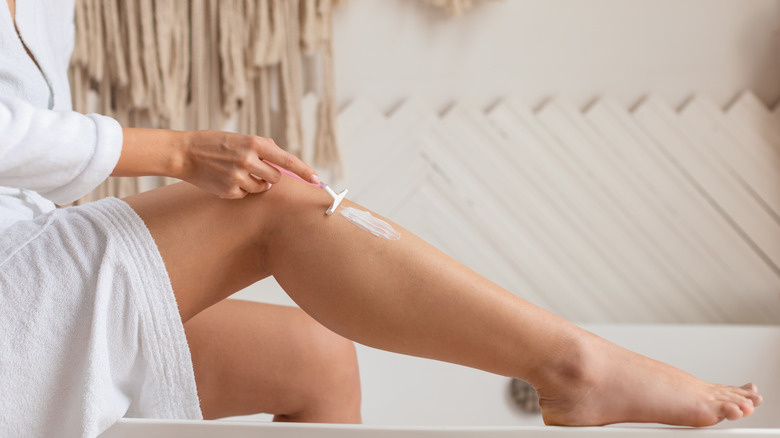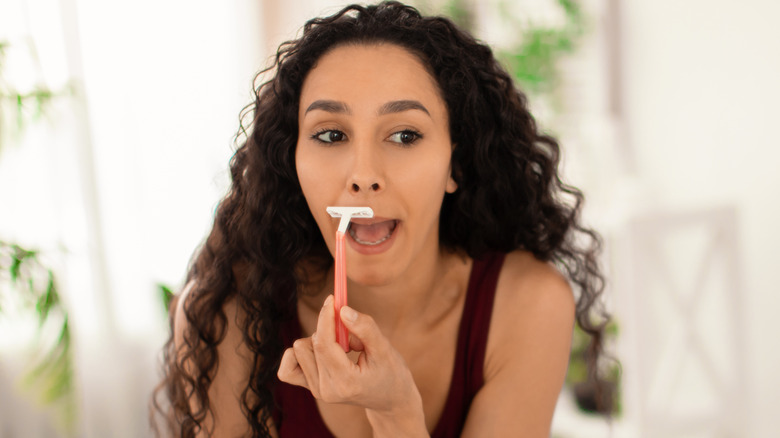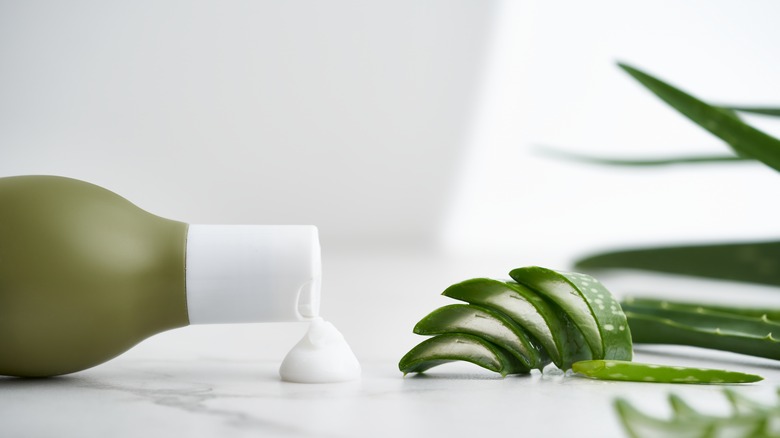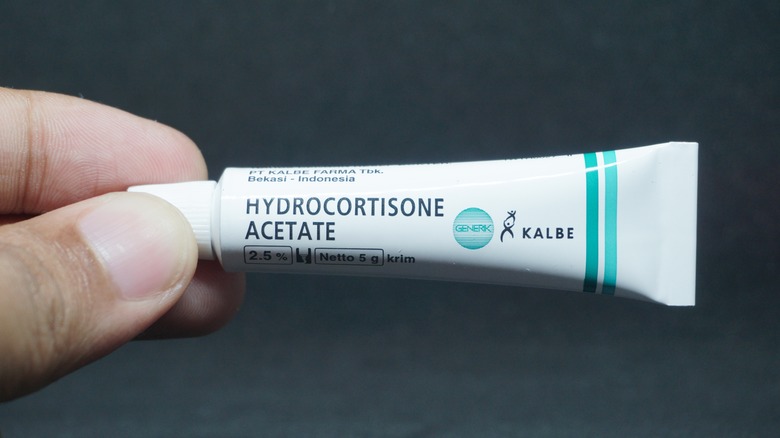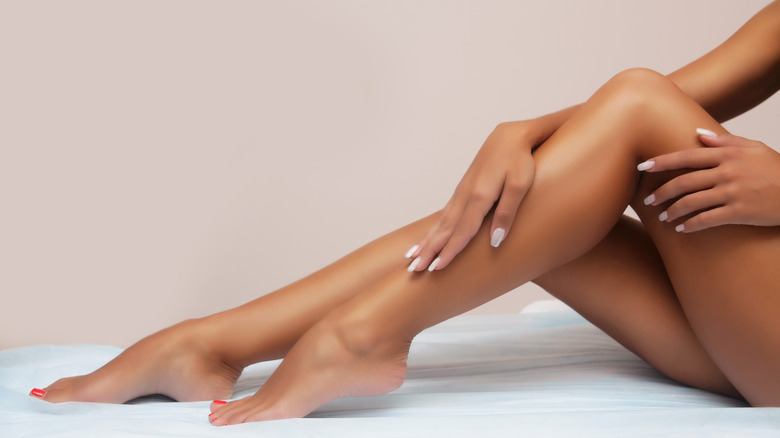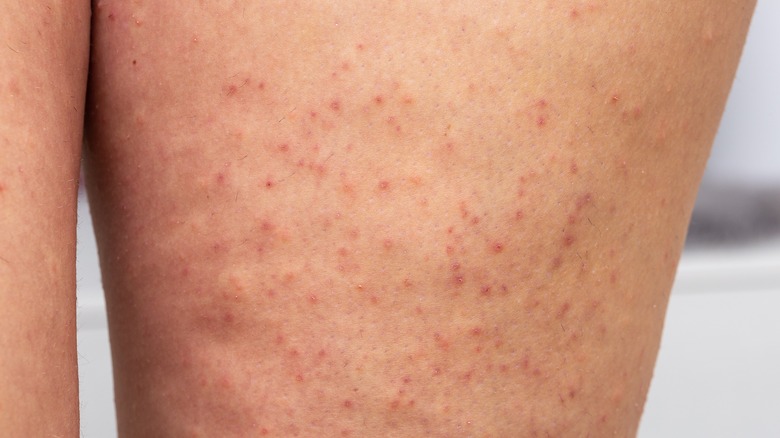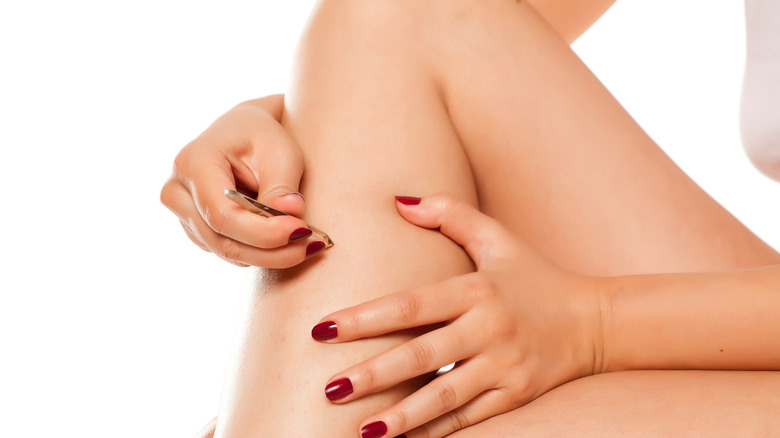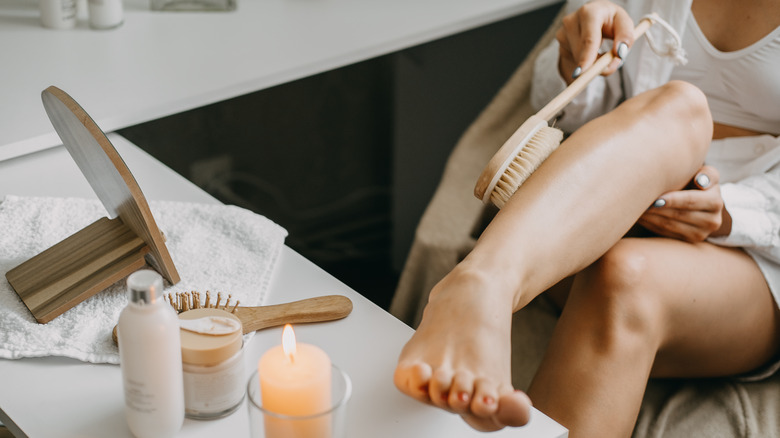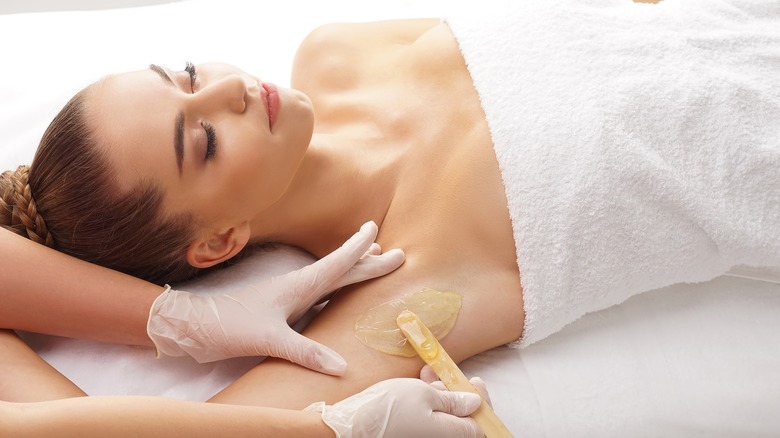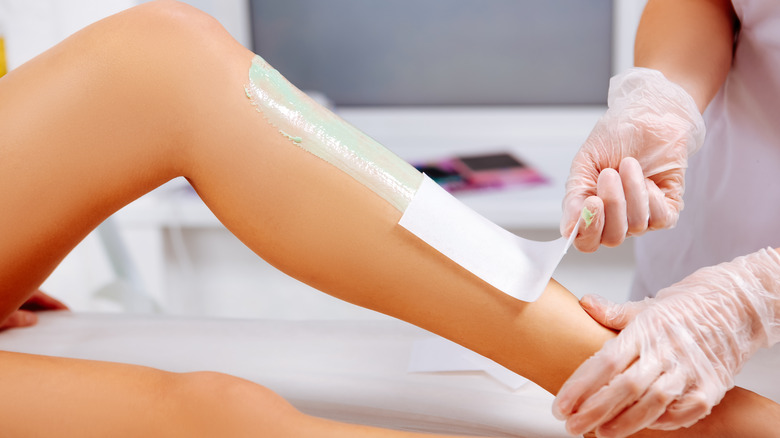Our Guide To Treating And Preventing Razor Burn And Ingrown Hairs
Whether you're new to the art of shaving (welcome!) or have been practicing it for years, there seems to always be something to learn to achieve that perfectly smooth skin afterward, yet a different way to prevent those pesky side effects from showing up. Keeping up with all the new techniques and products that promise to work shaving magic can be exhausting, so we've put them all together in one simple, exhaustive guide to help you make the best decisions for when you go bare-skinned.
We've especially taken care to walk you through razor burns and razor bumps (also known as ingrown hairs, FYI), since these two issues are what most people hate dealing with most when shaving. We'll explain all about razor burns and bumps, including how to treat them when they become a problem and how to prevent them from showing up in the first place. We've got the roundup of tips, techniques, and products — with input from medical professionals as well — so clear your schedule and focus. We're spilling the deets on what to know to treat and prevent razor burn and ingrown hairs to achieve the best shave of your life.
What's a razor burn?
Before we jump into the deep end of fixing a problem, let's define razor burns. If you've never had the pleasure of experiencing one, a razor burn is when your skin becomes irritated after shaving and can manifest as itching, redness, or even flaking skin.
Here's the kicker: It can happen right after you've shaved or up to a few hours later, so you might just think you're in the clear when the itching creeps up on you. And, unfortunately, it doesn't always resolve promptly either. A razor burn can last up to two or three days, which is longer than we'd like to stay in an itchy state if you ask us.
You're more likely to get a razor burn when you shave in the opposite direction that the hair is growing if you shave with an old or dull razor, if you shave too quickly (and, thus, tug on skin or hair follicles), or if you shave on dry skin.
How to treat a razor burn naturally
It turns out that the best treatment for a razor burn is none at all. As Robert Finney, a dermatologist in New York, shared with NBC News, it's best to abstain from shaving and let the razor burn go away on its own. Of course, that doesn't mean there isn't anything you can do.
Keep the skin moisturized while the razor burn is resolving to lessen the itching sensation. Two great moisturizers that won't break the bank and are natural to boot are aloe vera and coconut oil. Board-certified dermatologist Jennifer Chwalek suggested to HuffPost that both are great options for keeping your skin hydrated, as they contain glycerin which helps "restore the barrier function of the skin," while also soothing the razor burn. "Coconut oil also hydrates irritated skin and has demonstrated anti-inflammatory activity," she added.
Both aloe vera and coconut oil seem like no-brainers, but Chwalek also dropped a somewhat unusual remedy for razor burn: marshmallow extract. A few other lesser-known salves for razor burns include sweet almond oil, tea tree oil, baking soda paste, and calendula cream. Although most of these have no scientific evidence backing their effectiveness, they may still work well for your specific skin type.
Treating a razor burn with over-the-counter products
Natural remedies have their place, but if you find yourself regularly having razor burn, it might be time to step up your game. Having some over-the-counter medication or treatments at home might be the best way to quickly and effectively get over your razor burn. Use creams that contain hydrocortisone to ease redness and inflammation. It can also be used to ease the itchiness associated with razor burn.
After-shave lotion can also be an easy remedy for razor burn — applying it after your shave can help your skin recuperate faster and potentially prevent razor burn from returning. Glycolic acid can also be instrumental in helping your skin when you have a razor burn — look for creams or lotions that contain it; these are specifically targeted toward moisturizing the skin.
Witch hazel extract can also be a good way to soothe your razor burn. Just be careful to test it on a small area, as most witch hazel products contain alcohol, which can be even more irritating to your skin. Lastly, you could opt for something that might already be in your pharmaceutical cabinet: salicylic acid. This is a common ingredient in many acne products that might just be the ingredient you need to soothe your razor burn.
How to prevent razor burns
Even though you might have options for treating razor burns, wouldn't you much rather not have them in the first place? We have a few tips for how to get a smooth shave and not have to worry about the after-effects of the shave. First, give yourself plenty of time to shave. Rushing through your shave means you're more likely to not only cut or nick yourself but also to give yourself a razor burn, as you'll be less mindful of how much pressure you're applying.
Check your razor to make sure the blades are not dull or old. Shaving with old blades will cause more harm, as the dull blades will pull on the hair and cause chafing. Once you've cleared yourself some time, start by softening your hair and skin either by showering or applying moisturizing and softening shaving cream to the area you're going to shave.
Shave in the direction of your hair, as this will cause less irritation, and don't go over the same area more than once. Keep the pressure of your blade the same throughout the entire area you're shaving. Once you're done, rinse off your skin completely, and apply a moisturizing cream.
What are ingrown hairs?
Caroline Robinson, dermatologist and founder of Tone Dermatology, told CNN Underscored that ingrown hairs "occur when the hair curves backward and pierces the skin or becomes trapped under the skin." It usually occurs because dead skin cells block the follicle, and new hair can't penetrate above the skin layer. According to Robinson, people with curly hair are particularly susceptible to ingrown hairs. They tend to occur in the bikini area and on the chin.
Ingrown hairs are also sometimes referred to as razor bumps, with the terms often used interchangeably. Unlike razor burn, ingrown hairs don't show up for a few days to a week after shaving because that's when your hair has grown back enough to peek through your skin.
Many ingrown hairs are not irritating and resolve themselves without you ever knowing about them. Of course, that doesn't mean they won't be noticeable, since they show up as tiny bumps on your skin. If you have one or two here and there, it's no big deal, but they might become a nuisance or even painful if you have many after shaving. They can be itchy or sore and can even become inflamed or infected if the hair can't escape.
How to treat ingrown hairs naturally
Ingrown hairs can be either a pain or no big deal. But if you're dealing with the former rather than the latter, you need some way to get rid of the pesky problem once it shows up. We love natural and gentle home remedies for treating razor bumps, though the best treatment is usually what you would do for preventing ingrown hairs: exfoliation.
When exfoliating, use a warm compress to help release the hairs from underneath the skin. Prepping your skin can also help release the hairs from underneath. You can exfoliate using a dry brush or a manual exfoliator, but be mindful that it might take a few times to fully remove your ingrown hairs. Once you see the hair exposed, you can use sterile tweezers or a needle to gently pull the hair out.
In rare cases, an ingrown hair can become inflamed or infected with pus surrounding it. Although these types of ingrown hairs can still be treated at home, they can be riskier, and you shouldn't go digging around to look for a hair that might not even be there. Once you have an ingrown hair that's infected, think about visiting your healthcare provider.
Treating ingrown hairs with over-the-counter products
The beauty industry has developed numerous products in the last few years to help deal with ingrown hair. One excellent option is using a product with retinoid medication. You can use retinoid medication to gently exfoliate the area around the ingrown hair to get the hair to rise to the surface.
A few other ingredients can be used to treat ingrown hairs once they develop. These include benzoyl peroxide, salicylic acid, and glycolic acid, as well as any AHA or BHA, witch hazel, and willow bark extract. Many of the products on the market use a combination of these ingredients. For instance, products can use both salicylic acid and glycolic acid to unclog pores and create a cleaner environment for your hair to regrow through the skin.
These over-the-counter products can help in different ways either by unclogging pores, lessening inflammation from ingrown hairs, reducing the size of pores, or stopping ingrown hairs from returning.
Complications of ingrown hairs
Ingrown hairs usually resolve themselves in one to two weeks, but occasionally they don't. You can usually tell that an ingrown hair will need some help when it becomes inflamed, swollen, red, is sensitive or even painful to touch, develops pus around the trapped hair, or the area becomes discolored.
Seek a healthcare professional's help in these cases, especially if this kind of ingrown hair is a regular occurrence. A dermatologist or even your family physician can prescribe an antibiotic to help with any infections that may have developed (if your ingrown hair has pus, it's a sign of infection). This antibiotic can be in either oral or topical form to apply directly to the infected site.
If your ingrown hair is not infected but still giving you a hard time, your doctor could prescribe a steroid cream instead. A steroid will help lessen inflammation and allow you to take the usual route for removing an ingrown hair: exfoliation. Your doctor could also prescribe a retinoid to help slough off dead skin and hopefully prevent the reoccurrence of ingrown hairs.
How to prevent ingrown hairs
There's no way to guarantee you'll never have an ingrown hair, but there are a few steps to take to ensure you're minimizing your chances. The first step is to exfoliate the area before shaving.
Removing dead skin from the surface not only helps prevent ingrown hairs later (since there will be less skin blocking the hair follicle's exit) but can also help prevent razor burn. Once you've sufficiently exfoliated your skin, use a sharp razor blade to shave, going in the same direction as your hair grows. This will not cut your hair as short and probably give you one or two days less time before you have to shave again, but it will result in fewer ingrown hairs.
Finally, make sure to moisturize after you finish shaving to protect your skin. This also helps keep your skin plump and smooth and can help keep your pores from becoming blocked with dead skin cells.
Shaving vs. waxing for razor bumps and burns
Unfortunately, neither shaving nor waxing will reduce your chances altogether of getting razor bumps or burns. Both shaving and waxing have their benefits and downsides, and it just depends on what you're willing to sacrifice to get what you want. WOW Skin Science, however, does affirm that waxing causes fewer ingrown hairs than shaving.
Jodi Shays, owner and founder of QB Skincare, told Byrdie, "Waxing lasts longer over time because hair is being removed from the follicle whereas shaving just cuts it at the surface." This means you'll also have fewer ingrown hairs over time because it takes your hair longer to grow back. Even so, not everyone is kosher with the painful method of waxing — leaving shaving as their only option.
As long as you cut or manually remove hair, you're going to get ingrown hairs. The only way to completely stop ingrown hairs in their tracks is through laser hair removal.
How to shave properly to minimize ingrown hairs and razor burn
Now that you know the issues and difficulties that come with shaving, let's go through the steps to minimize your chances of getting ingrown hairs or razor burns in the future. First, allot enough time to properly shave — although it might be tempting to quickly run a razor down your legs a few times a week, this will create more problems than it will fix. Instead, while in the shower or tub, spend at least 10 minutes making sure your skin is properly hydrated to prevent those pesky razor bumps.
Next, exfoliate using a fine scrub or loofah to remove as much dead skin from the surface as possible before starting your shave. Make sure your razor blade is clean and sharp — you should be replacing your razor blades every five to seven shaves. "The quality of your blade and the amount and thickness of hair will all contribute to how quickly your blade dulls. If your razor sits in the shower, it will also rust and collect more bacteria," Jessie Cheung, a board-certified dermatologist and founder of Cheung Aesthetics & Wellness, shared with Healthline. Shave in the direction of your hair growth, and try to avoid going over the same area more than once. Lastly, moisturize your skin once you're out of the shower, and keep it moisturized between shaves.
How to wax properly to minimize ingrown hairs and razor burn
Most people opt for salon waxing treatments since it's easier and the skilled technicians know what to do. But if you're not comfortable enough to make regular salon visits, or if you want to save a few bucks, you can also wax your excess hair, including your armpit hair, at home. Before waxing, the American Academy of Dermatology recommends ensuring your hair is long enough — the optimal length should be between ¼ and ½ inch. To help ease any pain, take an over-the-counter pain medication about 30 minutes beforehand.
Next, wash and dry the area you're going to wax. Follow the directions on the container to warm up the wax. Apply the wax to a small area first in the direction of hair growth, and check for any skin reactions, such as redness, itchiness, or breakouts. If no reaction occurs, continue to apply the wax to the entire area.
Once the wax or paper has hardened, grasp a part of the wax or paper firmly, hold skin taunt at the other end, and pull in the opposite direction of hair growth with short, quick motions. When you're done waxing, apply an oil-free moisturizer to soothe your skin. For the next few days, you'll want to wear loose clothing, avoid hot baths or showers, and apply cold packs to your waxed skin to lessen immediate pain.
